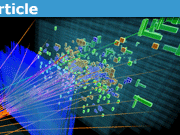Learn The Main Conceptual Ideas of Anyon Particles
Every quantum physicist knows that all particles are either bosons or fermions. And the standard textbook argues that this so does not depend on the number of dimensions.
On the other hand, you may have heard that in 2 dimensions particles can be anyons, which can have any statistics interpolating between bosons and fermions. And not only in theory but even in reality. But how that can be compatible with the fact that all particles are either bosons or fermions? Where is the catch?
This, of course, is discussed in many papers (and a few books) devoted to anyons. But my intention is not to present a summary of the standard literature. I want to explain it in my own way which, I believe, demystifies anyons in a way that cannot be found explicitly in the existing literature. I will do it in a conceptual non-technical way with a minimal number of explicitly written equations. Nevertheless, the things I will say can be viewed as a reinterpretation of more elaborated equations that can easily be found in the standard literature. In this sense, my explanation is meant to be complementary to the existing literature.
Consider a 2-particle wave function ##\psi({\bf x}_1,{\bf x}_2)##. The claim that it is either bosonic or fermionic means that it is either symmetric or antisymmetric, i.e.
$$\psi({\bf x}_1,{\bf x}_2)=\pm \psi({\bf x}_2,{\bf x}_1) ….. (1)$$
But suppose that the wave function satisfies a Schrodinger equation with a potential ##V({\bf x}_1,{\bf x}_2)##, which has a property of being asymmetric
$$V({\bf x}_1,{\bf x}_2) \neq V({\bf x}_2,{\bf x}_1) .$$
In general, with an asymmetric potential, the solutions of the Schrodinger equation will not satisfy (1). And yet, no physical principle forbids such asymmetric potentials. It looks as if it is very easy to violate the principle that wave function must be either bosonic or fermionic.
But that is not really so. The principle that wave function must be symmetric or antisymmetric refers only to identical particles, i.e. particles that cannot be distinguished. On the other hand, if the potential between the particles is not symmetric, then the particles are not identical, i.e. they can be distinguished. In that case, (1) does not apply.
Now assume that the asymmetric potential takes a very special form so that the wave function of two non-identical bosons or fermions takes the form
$$\psi({\bf x}_1,{\bf x}_2)=e^{i\alpha} \psi({\bf x}_2,{\bf x}_1)$$
where ##\alpha## is an arbitrary real number. This is the anyon. And there is nothing strange about it, it is simply a consequence of the special interaction between two non-identical particles. The effect of interaction is to simulate exotic statistics (exotic exchange factor ##e^{i\alpha}##), while the “intrinsic” statistics of particles (i.e. statistics in the absence of exotic interaction) is either bosonic or fermionic.
The only non-trivial question is, does such interaction exists? It turns out (the details of which can be found in standard literature) that mathematically such an interaction exists, provided that the particles live in 2 dimensions and that the potential is not really a scalar potential ##V({\bf x}_1,{\bf x}_2)## but a vector potential ##{\bf A}({\bf x}_1,{\bf x}_2)##. And physically, that is in the real world, such interaction does not exist for elementary particles such as electrons, but only for certain quasi-particles in condensed matter physics. These are the main conceptual ideas of anyons, while the rest are technical details that can be found in the standard literature.
Theoretical physicist from Croatia








Without going into much detail, it seems logical that an anyon would be a 2-d vector class, simply due to its similarities with dimensionality equations: the lower the dimension, the larger number of applicable equations, and the more parallels exist.
[QUOTE="Silviu, post: 5613347, member: 588158"]Hi! I am new to this topic and a bit confused. In the normal boson and fermions statistics, as you said, we have identical particles. So, depending whether the wave function is symmetric or not, we can argue that that particle is a boson or fermion. But in the example you gave, if instead of ##pm 1## we have another factor, we have an anyon. But you also said that this is the case only if the 2 particles are not identical, so we can have an asymmetric potential. So what exactly is called an anyon, as we have 2 different particles, that individually are either bosons or fermions? Is the wave function itself that is called anyon? Thank you![/QUOTE]The two particles, which in the absence of this specific interaction would behave as bosons or fermions, behave as two anyons due to interaction. Since they behave as two anyons, it is common to say that they "are" two anyons.
[QUOTE="Silviu, post: 5613347, member: 588158"]we have 2 different particles, that individually are either bosons or fermions?[/QUOTE]No. A single particle alone in the world is neither boson nor bermion nor anyon. The latter are properties of the corresponding many-body system.
Hi! I am new to this topic and a bit confused. In the normal boson and fermions statistics, as you said, we have identical particles. So, depending whether the wave function is symmetric or not, we can argue that that particle is a boson or fermion. But in the example you gave, if instead of ##pm 1## we have another factor, we have an anyon. But you also said that this is the case only if the 2 particles are not identical, so we can have an asymmetric potential. So what exactly is called an anyon, as we have 2 different particles, that individually are either bosons or fermions? Is the wave function itself that is called anyon? Thank you!
Really no such thing as particles